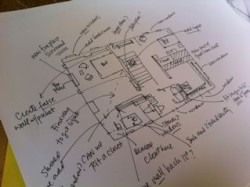Restoration of Joy #2
Monday, March 14, 2011

I’ve been around renovation, restoration and decorating since before I could stand up in a crib – and trust me, waiting for the day when this work is nothing but well-funded fun, is like waiting for the tooth fairy. On top of it, far too often these projects start with something close to a disaster. And -- regardless of the nature of the problem, it’s never a good time. All to say, very few of us will ever approach this kind of work with a calm head and ‘extra’ money. I know that we didn’t.
When it was clear that we were going to have to gut most of the house, the options of change were enormous. Where to start? Well, I knew we couldn’t raise the roof, and – at least on this stage of development, we wouldn’t change the footprint. We chose to have plumbing stay where it was, with some minor changes. But interior walls could move. Detailing could be added. Doors and hardware could be upgraded. Bathtubs could be bigger, or they could become showers. We could have storage and closets, insulation and thermopaned windows – the things an 1830’s house (with a hundred years of badly informed and executed accretions) weren’t giving us.

As far as aesthetics, we also knew that we didn’t want to lose the quality inherent in the age of the house and its elegant small, square rooms. In fact, we wanted to enhance this authentic quality. We did not want to lose the wonky, tilted floors or the scrambled angles in the upstairs ceilings. Clearly, we would have to do this with a very light hand. And a lot of reference.

We could see from those pictures that craftsman’s detailing was inherent in the looks that we most liked. It meant that the rooms themselves might stay, for the most part, very much the same in structure, but very different in detail. And that was a major insight. Surface and moldings, hardware and paint were going to be important. And, we agreed that as much of it as possible should be handmade. We were very lucky in that we had the supremely talented craftsman, Jeff Memoli, heading up our team.
So – in approaching design: Limits and inspirational reference. Somewhere between the two you’ll discover your project.
Next, we’ll begin to move inside. Hold on to your hard hats.
